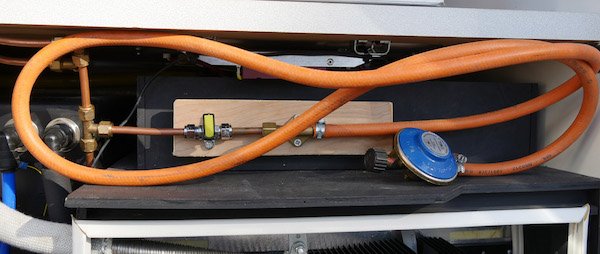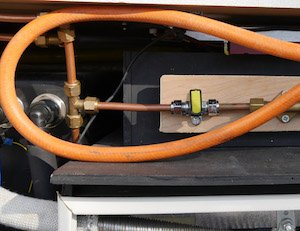This post has already been read 7714352 times!
Many of us have found that the underfloor LPG tanks have several advantages: efficient storage and economy being two obvious ones. However, whilst touring in Greece in 2012, we were confronted with a major disadvantage – what do you do if you are running low on gas and there is no LPG filling station within a hundred miles or so? Yes I could find service centres with bottles and connections of all shapes and sizes, just no LPG at a pump. Such is the Peloponnesian Peninsular, a wild camping haven, which we had to abandon slightly earlier than planned in order to continue cooling the beer via hook-up. Well the temperature was getting way into the thirties! This also accounted for the fact that our fridge had been working so hard for around three weeks that it had consumed most of the contents of a full LPG tank.
This all set me thinking about my first 2005 Murvi. There was the inconvenience of the small standard gas bottle taking up valuable space in the shower room cupboard, but the advantage of the second tail and regulator for a 907 Camping Gas bottle. Camping Gas is now very expensive of course, but can be easily obtained almost anywhere.
So would it not be possible to rig up a similar system in conjunction with the LPG system of my present Murvi?
Well yes and it was quite simple really. First turn the gas off! Next cut the fridge supply pipe, where it is easily found behind the nearside rear door, in order to insert an 8mm Tee. Onto the Tee fix an 8mm gas tap and then the correct fitting onto which can be securely attached a length of orange gas hose which terminates at a Camping Gas regulator. I checked that the Camping Gas regulator delivers gas at the pressure which is specified for my fridge. With the main supply turned off I find that the fridge works perfectly from the Camping Gas supply. The whole conversion stores very conveniently in the space behind the hob. (See photograph)

Needless to say, as a DIY job, you must be totally confident about being able to make secure connections!
So how did gas supplies work out when we returned to the Peloponnesian Peninsular in 2017? LPG pumps have certainly increased in number, but we still ran low on gas in a remote area. Our emergency supply worked perfectly and enabled us to stay put rather than having to drive many miles for a fill-up or to find hook-up. Additionally the whole system can be secured inside the van, with the gas bottle sitting on the shower floor, or in the XL, on the kitchen worktop. So it can be left running when parked up in public places with no possibility of interference. I guess the temptation to leave the bottle in the XL rear store should be resisted where there are electrics, but no ventilation.
The full 907 bottle was surprisingly economical even in the high temperatures we experienced. Even with a generous thermostat setting I estimate a full bottle would have kept our largish fridge running for around 8 days.
I should mention that our underfloor tank was never actually empty. We continued to use that limited supply for cooking, but just isolated the supply from the tank to the fridge. However our emergency supply could supply both if need be.
By Vince Wright
Alan York comments:
A slightly simpler solution: Gaslow sell an adapter called a reserve cylinder connection hose. This plugs into the autogas filler and allows
you to fit an adapter at the other end to fit any type of LPG bottle. It
is £18.00 and ideally suited for countries where Autogas is in short
supply or non-existant.

Bill Finch writes:
I thought I had this sorted with underfloor large gas tank . Just go to the a station selling GPL and fill up using one of the connectors provided by Murvi. Well, long story short neither of the connectors worked in Spain, and so we were asking the station for their connectors. Perhaps one in ten fitted, so we spent a lot of time trying to find gas, until we went to France and our connectors worked very easily.
Morale of the tale; make sure you have the right connectors, (and there appears to be at least 6 potential fittings). Also, make sure you have a comprehensive list of suppliers. The best source we found was on a site called myLPG.eu which lists the suppliers nearest to you and gives GPS coordinates and a map. We used this in Lourdes with no problem. The only issue I have with the site is it doesn’t tell you in which form the LPG comes, I.e. Cylinder, pumped supply (Autogas ?). You could look into how this works in the UK before you go.
I hope this helps and would be interested to know which are the connectors you use in Spain because I am still not sure.